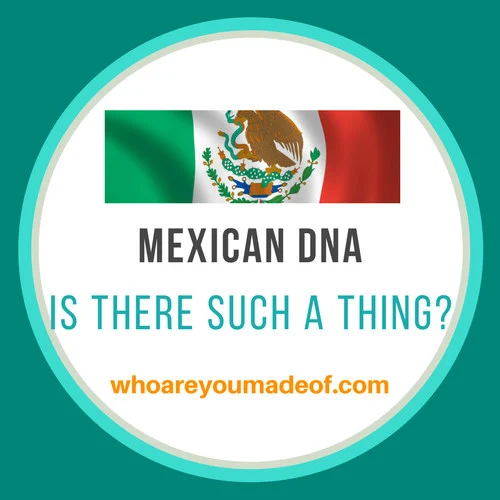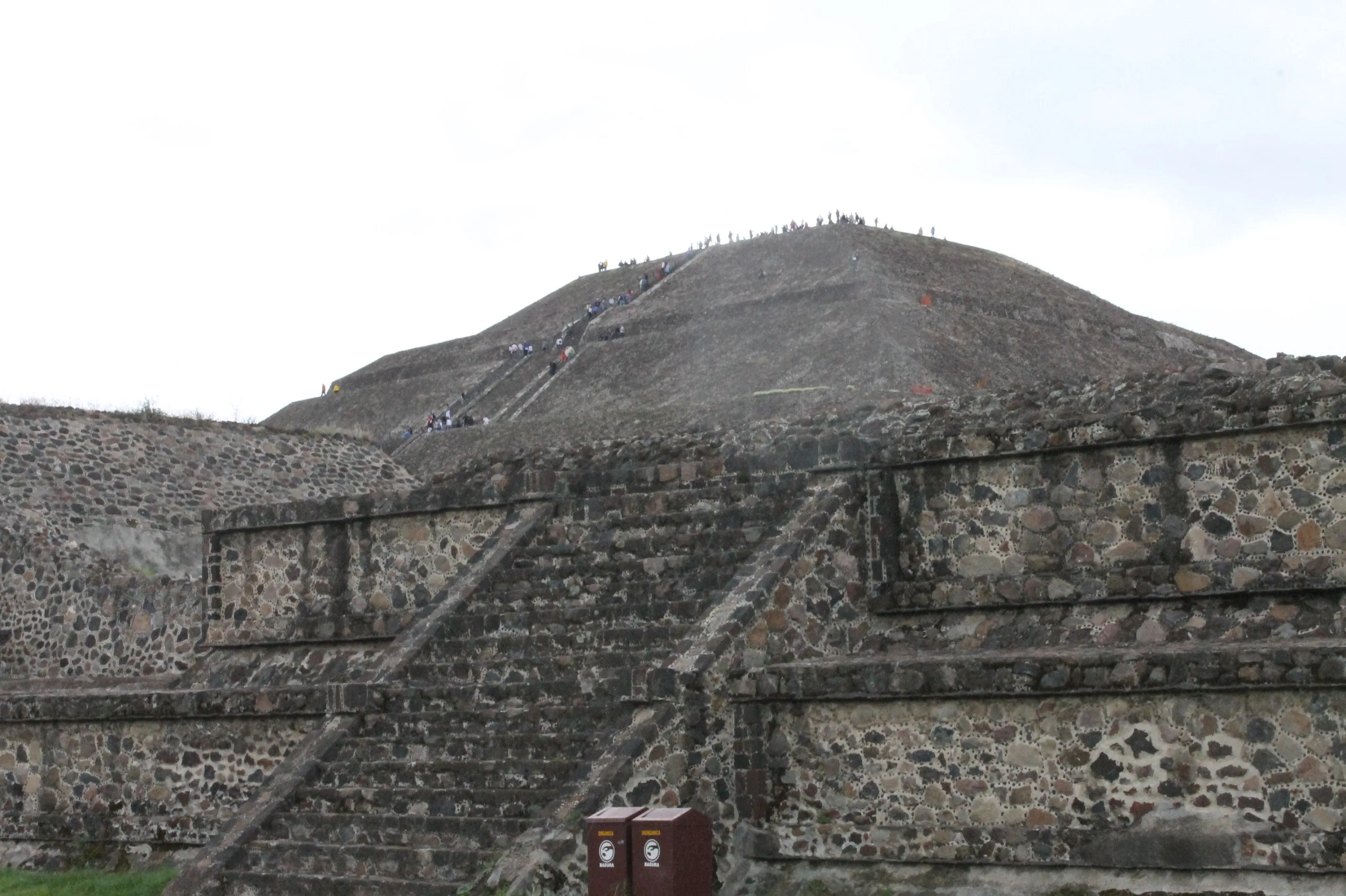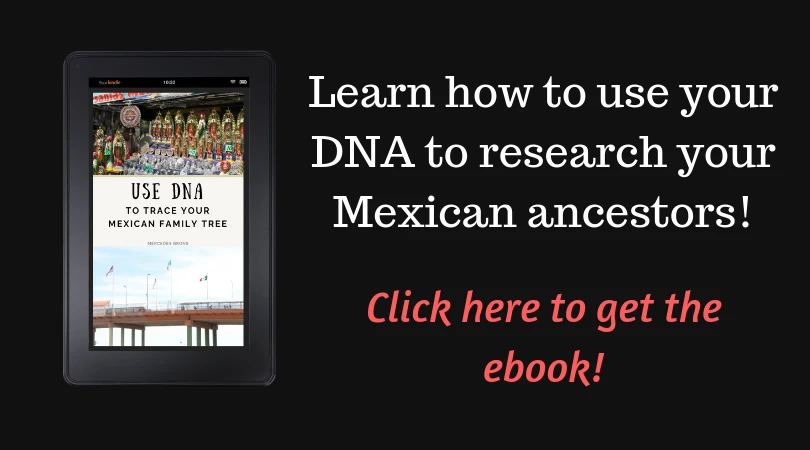A few weeks ago, one of my close acquaintances got his DNA results back. He showed them to his mother, who is the daughter of a Mexican father and and an American mother. Her initial response was that they were wrong: “Those can’t be right,” she said. “Where is the Mexican in your DNA results?” This led her son to ask the obvious question – is there such a thing as Mexican DNA?
In this article, we will discuss the genetic diversity that is found in Mexico, and hopefully answer that question.

- Click here to transfer your DNA to Family Tree DNA
- Uncover your ethnic origins and find new relatives with My Heritage DNA
Mexican DNA?
The easy answer is that there is really no such thing as “Mexican DNA”. There is a more complex explanation, however, that can help you understand your DNA results if you have Mexican ancestry.
As it turns out, Mexico is exceptionally genetically diverse. Many people are under the mistaken impression that Mexicans are a “combination of Spanish and indigenous blood”.
I’ve heard this particular myth expressed in many different ways. No matter how it is phrased, it is incorrect. Mexico’s population descends from a wide swath of the world, due to both conquest and immigration.

Native American DNA
As most of you probably know, there were people already living in what is now Mexico before the arrival of the Europeans. These people descended from a small original population that migrated from East Asia, most likely over the Bering Strait, into North America.
This original population grew, and their descendants populated two entire continents. By the time that the Europeans arrived, there were around 100 million people living in North and South America – all of them descended from that original group (or a few original groups, there is some debate).
Even though the population of these two continents was decimated by contact with Europeans due to several factors, there were still around 6 million indigenous individuals alive two hundred years later. At least one million of these people were residents of what Spain now called “Mexico”.
These people had their own very distinct language and cultures. In fact, there were almost three hundred different languages spoken in Mexico before the Spanish arrived – maybe more.
As you might expect, DNA from these original peoples still shows up in modern day Mexicans. Because these indigenous peoples were all descended from those small initial populations, and their descendants survived for thousands of years without mixing with genetic “outsiders”, their descendants show a stronger connection to each other than they typically would after many, many, many generations.
Since the DNA profiles look so similar, most DNA testing laboratories can’t tell the difference between indigenous people in North Dakota and someone from Guatemala or Peru. The result? Everyone with ancestry that traces back to the indigenous people of North and South America shows up with Native American DNA.
Some companies attempt to “tease” out the subtle differences, but I haven’t yet seen an accurate test that can really specify exactly where someone’s Native American DNA came from. If you have Mexican ancestry, this is why your test results say “Native American” if you tested with the major companies.
There are two different ways that researchers have measured the amount of Native American ancestry that modern Mexicans have:
1. Via mitochondrial DNA (mtDNA), which is passed down via maternal lines. This DNA mutates very slowly, and is a very accurate way to trace deep ancestry. Using this method, scientists have found that 85-90% of Mexican women have Native American ancestry.
2. The more common autosomal DNA test, which is like the one that Ancestry DNA offers, for example, shows that 30-46% of Mexicans still show Native American ancestry. Autosomal DNA disappears more quickly than mtDNA, which could be one reason that this number is much lower than the percentage shown with the mtDNA test.
European DNA in Mexico

As you know, the first Europeans that made contact with the inhabitants of Mexico were Spanish. There were many ways, both violent and non-violent, that Spanish DNA began to mix with the indigenous DNA of Mexico.
Once Spain established a government in Mexico, immigration to the territory was encouraged, and continued for hundreds of years. Naturally, there are many Mexicans with Iberian Peninsula DNA because of this.
But did you know that there have been immigrants (and others) from more than a dozen other European countries in Mexico since the 1500s?
More than one million Europeans migrated to Mexico while it was still a Spanish colony. Immigration continued, though at a slightly slower pace, after independence.
All in all, people from the following European countries made their home in Mexico:
- Spain
- England/Scotland/Wales
- Ireland (read about Irish DNA in Mexico)
- France
- Germany
- Italy
- Russia
- Poland
- Ukraine
- Bulgaria
- Romania
- Hungary
- And many, many more…
Modern Mexicans, and their descendants, will show DNA from these immigrants to Mexico, along potentially showing Native American ancestry. I have seen DNA results from people whose families have lived in Mexico for generations shock the test takers revealing their Russian and European Jewish ancestry. It’s amazing.
African DNA in Mexico
One of the most overlooked aspect of understanding “Mexican DNA” is the African influence on the genetic makeup of modern Mexico. There is surprisingly little research available on the prevalence of African DNA in Mexico’s population.
This is sometimes referred to as “The Third Root“, or Mexico’s “silent ancestry”. Regardless, there are very noticeable influences of various African cultures on modern day Mexican culture.
One thing that we do know for sure: There was a very active trade in enslaved people from the beginning of the colonial days to the year 1829, when Mexico’s first president of African ancestry, Vicente Guerrero, abolished slavery.
There are almost 1.5 million Mexicans who identify as “afromestizos” (basically, mixed European, African, and Indigenous ancestry), and many more who have African heritage who don’t know it, or who don’t acknowledge it.
The average percentage of DNA that shows up in an autosomal DNA test, like the one offered by Ancestry, can very. There are very little reliable statistics, however.
I have seen numbers as low as less than 1%, and as high as 8-9%. I know personally that the percentages are likely much higher than this in communities that are known to be afromestizo. I have a close family member whose father is from one of these communities in Mexico, and she shows 11% African DNA, and her father could have as much as twice that amount.
Asian DNA from Mexico?
Even lesser known than the presence of African DNA in Mexico is the influence of Asian migration to Mexico. Some of the migration occurred hundreds of years ago when the Spanish brought enslaved individuals from Asian countries.
In fact, during the colonial era, enslaved people, workers, and sailors came to Mexico from several Asian countries: Japan, Korea, Malaysia, the Philippines, Cambodia, Timor, India, Ceylon, China and others.
This aspect of Mexican ancestry is sometimes called “The Fourth Root” – though even less has been published on this topic than about Mexico’s African heritage.
Asian immigration to Mexico, both enslaved and free, was as high as 120,000 during the Spanish rule. One theory about why these people sort of “disappeared” into Mexico culture is because they and their descendants were encouraged to try to “pass” as indigenous Mexicans because that population was protected against “chattel slavery” (i.e. being born into slavery).
After Mexican independence in 1821, Asian immigration continued – and still occurs. There have been waves of immigrants from Japan, China, and Korea, for example. DNA from these immigrants, when shown on autosomal DNA results usually shows up as East Asia.
Hopefully, the big testing companies can eventually refine these regions so people can get a better idea of their ancestral roots.
Tracing your Mexican roots
One of the first ways to find out where your “Mexican DNA” came from is to start building a family tree. I prefer using Ancestry’s system for building my trees, since it’s pretty easy to use, you can attach it to your DNA results on the site, and can access records and attach them automatically (the best of all worlds).
Ancestry also has a good collection of Mexican records, though you do need a subscription to access them.
Talk to your older family members if possible, and ask them about names, dates, locations. Any little clue, no matter how insignificant or tiny, can help you get one generation further back in your tree.
Find out the names of the states where your Mexican family came from. When you ask for names, try to get both of the last names (it makes it much easier when searching for birth records, etc.)
What will your DNA show?
If you have Mexican ancestry, I bet you are curious to find out what might show up on your DNA results!
Learn More
These are some other articles that I have on this site that might be interesting to you, as they are related to the topics of this post.
- Iberian Peninsula DNA Ethnicity
- Iberian People: A DNA Perspective
- Hispanic DNA Ethnicity
- What is Gedmatch (a free resource for analyzing your DNA)
- Does Ancestry Test for Native American
- What is a Low Confidence Region on Ancestry
Conclusion
As you can see, a person with Mexican ancestry might have indigenous (Native American), European, African, and Asian roots. Were you surprised to find an ethnicity in your DNA results that you think came from your Mexican family?
I would love to hear your questions or story in the comments.
Thanks for stopping by!



Isabel Smith
Saturday 6th of May 2023
Hello- I did the dna from ancestry and I show some native 30-33% andn45% from Poland/Lithuania and then some Spanish, others. I was adopted so the only thing I know is that my blood mother was Mexican from possibly the San Luis Potosí area and my father was foreign? So after the dna it appears he might be Polish..any info on this i migration would be wonderful
Demaryarylmont, Matthew F.,
Wednesday 21st of October 2020
yes there are many gro;s that came from europe and some from asia to mexico. however it is NOT a myth that the majority of mexicans, the very first "mexicans" are of spanish and "native american" --indigenous people/blood. do not confuse the issue and peopls with words such as "modern mexicans." other european immigrants to mexico-- except the french if u know mexican history-- came many years later when the spanish/indigenous peope were already established
What is the Spain Ethnicity Region on Ancestry DNA? - Who are You Made Of?
Thursday 24th of September 2020
[…] results we see below matches the Spain ethnicity region with 1% of their DNA. He has extensive ancestry in Mexico on both sides of his family, and we can assume that the long, complicated relationship that Mexico […]